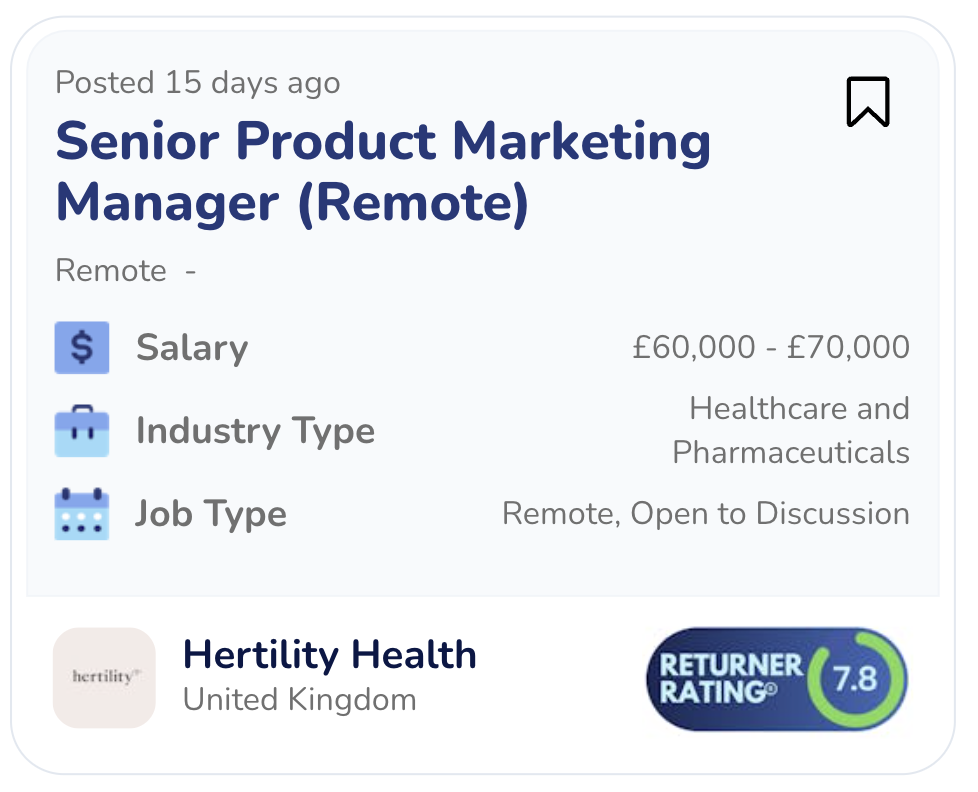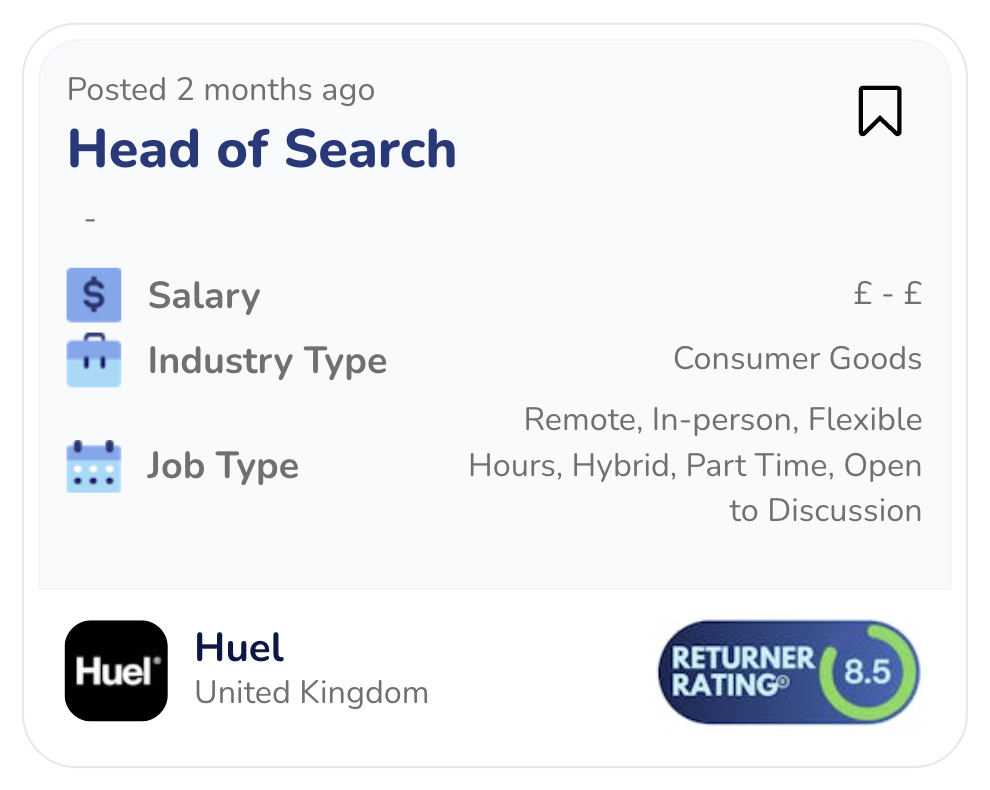Returning to work after a period of sick leave can be a challenging and emotional experience. Whether you’re coming back from a short or long-term illness, surgery, disability, or stress related leave the transition requires careful planning and support. It’s not just about obtaining a return-to-work doctor’s note or a medical certificate of fitness; it’s about addressing the physical, mental, and emotional aspects of re-entering the workforce. The right approach and resources can make this process smoother and more manageable, ensuring that you feel prepared and supported as you return to your professional life.
This comprehensive guide covers everything you need to know about returning to work after sick leave, including your rights, employer obligations, and practical tips for easing back into your role.
At ivee, we’re on a mission to help everyone return to work – without compromise.
Jump to:
- When should I return to work after sick leave?
- Finding a new role after sick leave
-
- Best types of jobs
-
- Understanding your rights during sick leave
-
- Statutory Sick Pay (SSP)
- Company sick pay
- Job protection
- Time off for medical appointments
- Sick leave and holiday entitlement
-
- Employer obligations after sick leave
-
- Communication during sick leave
- Return-to-work plan
- Phased return to work
- Risk assessment after sick leave
-
- Practical tips for returning to work after sick leave
- Return to work interview after sick leave
-
- What is a return to work interview?
- Am I required to have a return to work interview?
- How to prepare for your interview
- Potential interview questions
-
- Medical evidence
- Deciding not to return to work after sick leave
-
- Resignation letter template
-
- Legal rights and support
- Conclusion
When should I return to work after sick leave?
Assess your health
Medical clearance: Ensure you have a doctor’s note or medical certificate indicating that you are fit to return to work. Your doctor can provide guidance on any limitations or accommodations you might need.
Physical and mental readiness: Evaluate your own physical and mental well-being. Are you experiencing any lingering symptoms that could affect your performance or safety at work?
Consider your job demands
Nature of your job: Reflect on the physical and mental demands of your job. If your role is physically demanding, ensure you are fully recovered to avoid re-injury.
Workplace accommodations
Determine if your employer can provide necessary accommodations, such as modified duties or a phased return to work, to support your transition.
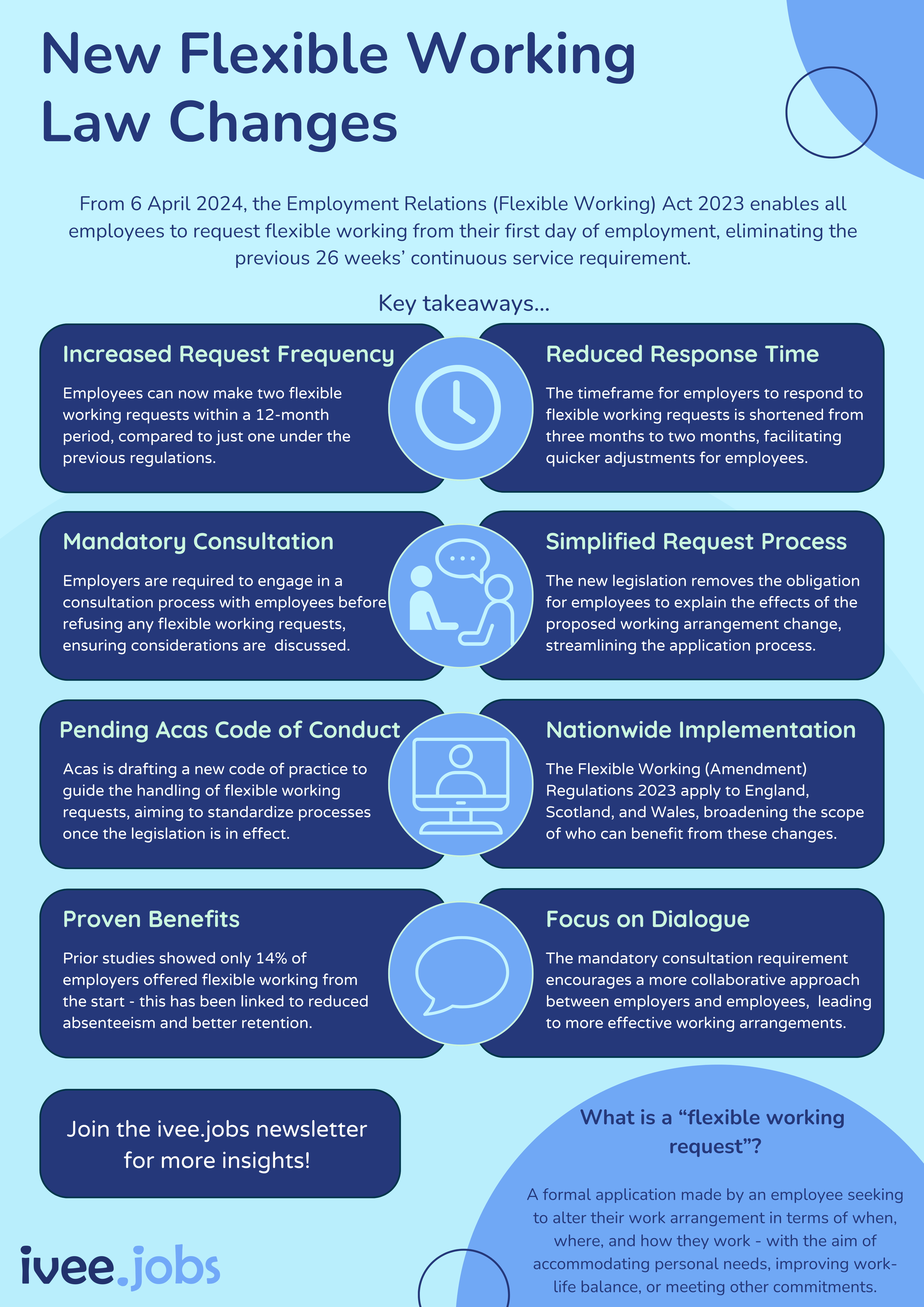
Finding a new role after sick leave
One of the most significant aspects to consider is finding a new role that accommodates your current health needs and promotes a smooth transition back into the workforce. Did you know that new flexible working laws came into effect this year?
Here are some key considerations and tips to help you find the right type of roles:
Flexibility
Managing doctor’s appointments and health needs
When returning to work, it’s crucial to consider the level of flexibility required to manage ongoing medical appointments and health needs. Look for roles that offer flexible working hours or part-time options. Many employers understand the importance of accommodating employees’ health needs and may offer flexible schedules that allow you to attend doctor’s appointments without sacrificing work responsibilities.
Remote-first
Working from home due to health conditions
For some individuals, working from home may be a necessity due to ongoing health conditions or mobility issues. Remote-first roles can provide the ideal solution, allowing you to maintain your productivity while ensuring you have a comfortable and safe environment to work in. When searching for new roles, prioritise companies that embrace remote work policies and have a strong infrastructure to support remote employees.
Hybrid
Balancing office and home work
Hybrid roles, which combine both in-office and remote work, can be an excellent option for those who need a balance between the two. This setup allows you to enjoy the social interaction and structure of an office environment while also providing the flexibility to work from home when needed. Hybrid roles can be particularly beneficial if your health condition fluctuates, giving you the adaptability to work in the environment that best suits your current state.
Company accessibility policies
It’s essential to look out for companies with robust accessibility policies. These policies should ensure that the workplace is accommodating to all employees, regardless of their physical or mental health conditions. Check if potential employers provide necessary accommodations, such as ergonomic workstations, assistive technologies, or modifications to work duties to fit your health needs. Companies committed to accessibility are often more supportive and understanding of your situation, fostering a more inclusive and adaptable work environment.
Additional considerations
-
- Health insurance and benefits: Ensure that the new role offers comprehensive health insurance and benefits that cover your medical needs. This can include coverage for prescriptions, therapy sessions, or specialist visits.
- Employee Assistance Programmes (EAPs): These programmes can provide valuable support, including counselling services, wellness programmes, and assistance with managing work-life balance. Read more here.
- Communicate your needs: Be upfront about your requirements during the interview process. Clear communication with potential employers about your health needs and required accommodations can help ensure a better fit and prevent future misunderstandings.
- Support networks: Seek roles in companies that emphasise strong support networks, whether through mentoring programmes, health and wellness initiatives, or supportive HR policies. Being part of an organisation that values employee well-being can significantly enhance your return-to-work experience. Join an ivee community to find your support network.
How ivee supports your job search after sick leave
At ivee, we specialise in helping individuals find roles that are friendly for those returning after sick leave. We understand the unique challenges that come with re-entering the workforce after a health-related absence, and we carefully vet job opportunities to ensure they offer the flexibility, support, and understanding that returners need. Whether you’re looking for remote work, part-time positions, or roles within mission-driven companies, ivee provides a curated list of job opportunities that align with your needs and values. Our platform connects you with employers who have robust sick leave policies and a commitment to fostering a supportive work environment, ensuring a smoother and more confident transition back to work.
Here are our top job picks for people returning to work after sick leave:
Understanding your rights during sick leave
Statutory Sick Pay (SSP)
- Eligibility: Employees who are sick for at least four consecutive days are entitled to Statutory Sick Pay (SSP) if they earn an average of at least £123 per week.
- Duration: SSP is payable for up to 28 weeks.
- Rate: The current rate of SSP is £109.40 per week (as of April 2024).
Employer notification: Employees must inform their employer of their sickness within seven days or by their employer’s deadline (if earlier).
Company sick pay
- Company policies: Many employers offer company sick pay schemes that may be more generous than SSP. These policies vary between employers and should be detailed in the employment contract or staff handbook.
Conditions: Company sick pay may depend on the length of service and other criteria set by the employer.
Job protection
- Unfair dismissal: It is unlawful for an employer to dismiss an employee for being sick. Employees are protected from unfair dismissal related to taking sick leave.
Disability protection: Under the Equality Act 2010, employees with long-term illnesses may be protected as having a disability. Employers are required to make reasonable adjustments to support these employees.
Paid time off for medical appointments
Company Policy: Some employers may offer paid time off for medical appointments as part of their sick leave policy, but this is not a statutory right and depends on the individual employer’s policies.
Sick leave and holiday entitlement
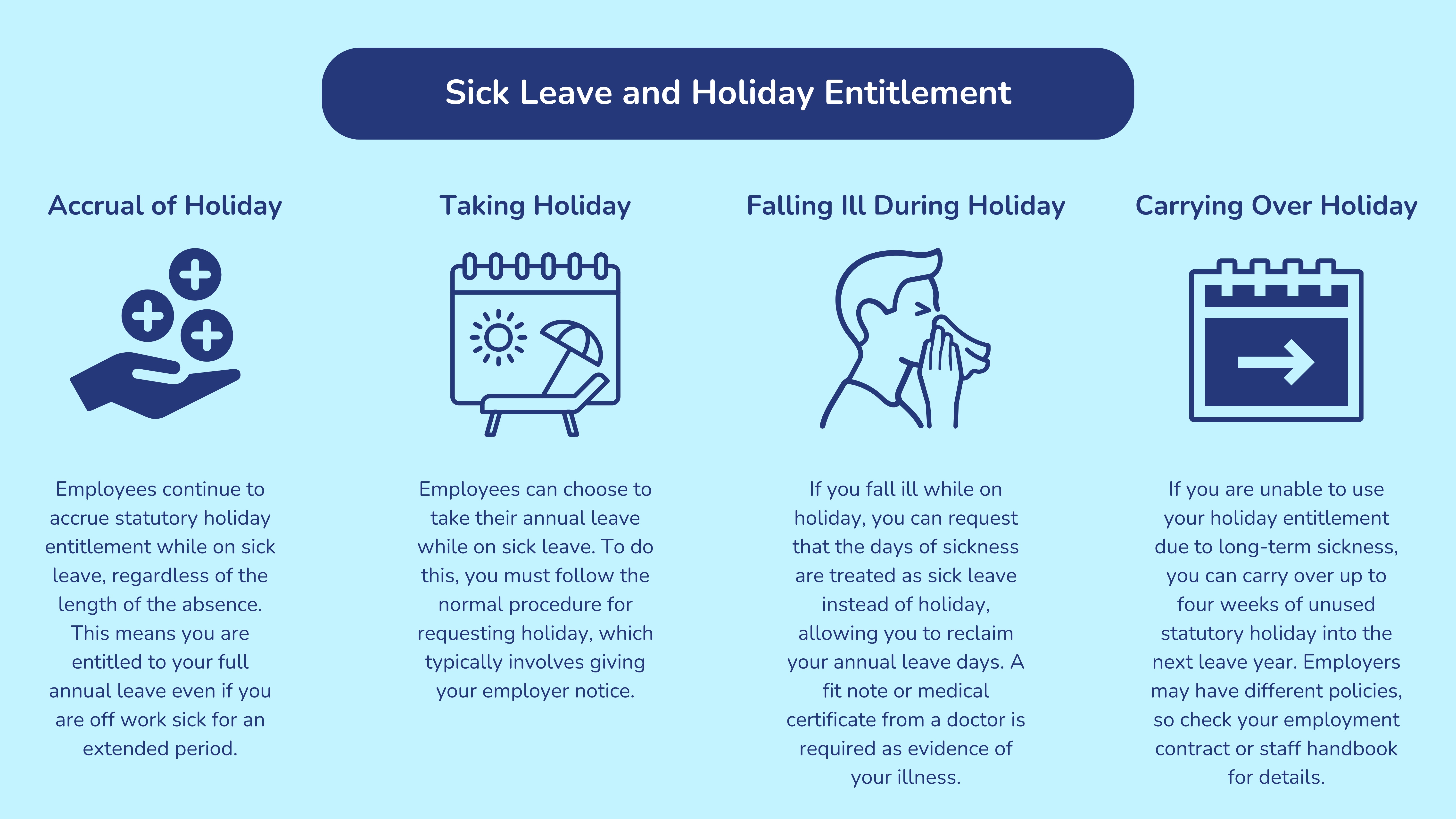
Join our community to stay in the loop about regulations relating to sick leave
Employer obligations post sick leave
Communication during sick leave
Employers should maintain reasonable contact during your sick leave to keep you informed of any changes at work and important updates.
As an employer, it’s crucial to avoid overwhelming employees who are on sick leave. For instance, individuals on leave due to stress may struggle with communication. To support them effectively, it’s important to minimise administrative tasks and reduce additional pressures.
Return-to-work plan
Employers are encouraged to support a smooth transition back to work by offering a phased return if requested. This can help you gradually readjust to your work routine.
Phased return to work after sick leave
A phased return to work is a structured approach that allows employees to gradually transition back to their full working hours and responsibilities after a period of sick leave. This method is designed to support the employee’s recovery and reintegration into the workplace by adjusting their workload and hours incrementally.
The employee’s circumstances will affect the nature of the plan and how long it is in place for. For example, some employees may simply need to start later and finish earlier to avoid the busy rush hour. Others may need to work mornings only as they are still suffering from fatigue. For other employees, it may work better to attend for full days, but only two or three per week.
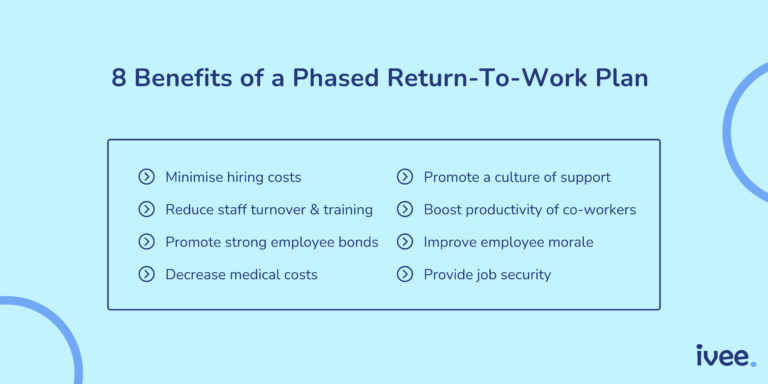
Conducting a risk assessment after sick leave
Conducting a risk assessment is a crucial step when returning to work after sick leave, especially if your illness or injury could impact your ability to perform your job safely. A risk assessment helps identify any potential hazards in the workplace and ensures that appropriate measures are taken to protect your health and well-being. Employers in the UK are legally required to ensure the health and safety of their employees under the Health and Safety at Work Act 1974. The risk assessment should be a collaborative process involving both you and your employer, aimed at facilitating a safe and smooth transition back to work.
Steps in the risk assessment process
-
- Initial discussion: Have an open discussion with your employer about your health status and any concerns you have about returning to work. Provide relevant medical documentation if necessary.
- Identify hazards: Work with your employer to identify any potential hazards in your job role or work environment that could affect your health.
- Evaluate risks: Assess the likelihood and severity of the identified hazards. Consider both physical and psychological risks.
- Implement control measures: Develop a plan to mitigate identified risks. This might include workplace modifications, flexible working arrangements, or changes to your duties.
- Monitor and review: Regularly review the risk assessment and make adjustments as needed based on your ongoing health status and feedback.
Practical tips for returning to work after sick leave
Communicate with your employer
Keep them informed: Regularly update your employer about your health status and your expected return date from you illness or injury.
Discuss adjustments: Talk to your employer about any necessary adjustments. For example, if you are coming back from an injury or have a disability you may need access adjustments. Whereas, if you have been struggling with your mental health you may prefer to work from home rather than come into the office. Other accommodations such as modified duties, flexible hours, or a phased return can also be discussed.
01
Stay connected
Communicate with colleagues: Keep in touch with your colleagues before and after your return from sick leave to stay updated on any changes at work. Download our free email template below:
02
Maintain health and wellbeing
Regular breaks: Take regular breaks throughout the day to rest and recharge.
Healthy habits: Maintain a healthy diet, stay hydrated, and get enough sleep to support your overall well-being.
Exercise: Incorporate light physical activity into your routine to boost your energy levels and mood.
03
Be patient with yourself
Adjust expectations: Understand that it may take time to get back to your full productivity level. Be patient with yourself and adjust your expectations accordingly.
Flexible approach: Be open to modifying your return-to-work plan based on how you’re feeling and any feedback from your employer or healthcare provider.
04
Follow medical advice
Adhere to recommendations: Follow your doctor’s advice and recommendations for a safe and healthy return to work.
Schedule follow-ups: Keep regular follow-up appointments with your healthcare provider to monitor your progress and address any concerns.
05
Not sure how to communicate your return after sick leave? We’ve got the PERFECT template for you:
Join the ivee community!
Join our Facebook group. Whether you’re looking to reconnect with like-minded returners, seek advice on returning to work after maternity leave, or share your experiences, our Facebook community is here to help you navigate your journey back into the workforce.
You’ll find:
👉 Latest regulatory changes regarding maternity leave
👉 CV templates for women returning to work
👉 Latest industry updates
👉 Resources and guides to help you on your job hunt
👉 Confidence-building events, webinars and advice on all aspects of returning to work
Our Facebook community
Return to work interview after sick leave
What is a return to work interview after sick leave?
A return to work interview is a meeting between an employer and an employee who has been on sick leave. The purpose of this interview is to facilitate a smooth transition back into the workplace, address any concerns, and discuss any adjustments or support that might be needed. It is the time for you to bring up any adjustments that may help you with accessibility or minimise stress. It’s an opportunity for both parties to ensure that the employee is ready to resume their duties and to identify any potential issues that might affect their performance or well-being.
Am I required to have a return to work interview?
While return to work interviews are not legally required in the UK, many employers use them as a best practice to support their employees’ return to work and to comply with health and safety regulations. Some companies have formal policies that mandate these interviews, while others may conduct them on a case-by-case basis, depending on the nature and length of the absence.
How to prepare for a return to work interview after sick leave
Preparation is key to making the most of a return to work interview. Here are some tips to help you get ready:
-
- Review your doctor’s recommendations: Bring any relevant medical documents, such as a fit note or medical certificate, that outline any restrictions or recommendations from your healthcare provider.
- Reflect on your health and well-being: Consider how you are feeling and any ongoing symptoms or concerns. Be ready to discuss these openly with your employer.
- Think about adjustments: Identify any adjustments or accommodations that might help you ease back into work. This could include flexible hours, a phased return, or changes to your workload.
- Prepare questions: Think about any questions you might have regarding your return to work, company policies, or available support.
Download our potential sick leave interview questions below:
Medical evidence
-
- Doctor’s note: For sickness absences longer than seven days, employees must provide a fit note (previously known as a sick note) from their doctor.
- Self-certification: For absences of seven days or less, employees can self-certify their illness using a form provided by their employer.
- Fit note: A fit note may indicate if an employee is fit to return to work with certain adjustments, this can be obtained from your GP or hospital doctor. It may also include suggestions for changes your employer could make to help you when you are back at work. This is sometimes referred to as a return to work letter, note, form or medical certificate.
Deciding not to return to work after sick leave
If you decide not to return to work after sick leave, here are some steps to take:
- Inform your employer: Provide your employer with a formal resignation letter, giving the required notice period as specified in your employment contract.
- Return company property: Ensure you return any company property, such as laptops or mobile phones, before your last working day.
- Understand your rights: Be aware that if you received enhanced sick pay (above the statutory amount), your employer may require you to repay some of the additional pay if you do not return to work.

Legal rights and support
If you face any issues or discrimination related to your sick leave or return to work, there are several avenues for support:
-
- Acas (Advisory, Conciliation and Arbitration Service): Provides free and impartial information and advice to employers and employees on workplace relations and employment law.
- Employment tribunal: If necessary, you can take legal action against your employer through an employment tribunal.
Trade unions: Membership in a trade union can provide additional support and representation in workplace disputes. Find the union for you:
Conclusion

Returning to work after sick leave can be a daunting journey, but with the right support and preparation, it can be a positive and manageable transition. Whether you’re recovering from a short-term illness, surgery, long-term disability, or stress-related leave, it’s essential to understand your rights, communicate effectively with your employer, and consider flexible work options that accommodate your health needs.
At ivee, we’re dedicated to assisting individuals in finding roles that not only match their skills but also provide the necessary support and flexibility to ensure a smooth and confident return to the workforce after sick leave. By leveraging the resources and guidance provided in this comprehensive guide, you can navigate your return to work with greater ease and assurance.
Ready to return to work?
Create an ivee profile and start browsing our flexible jobs today!
Create profile!Featured Blog Posts
